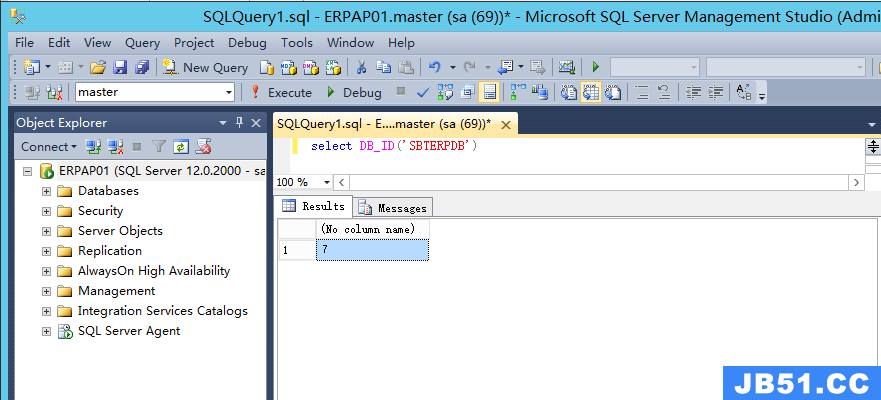在sql Server数据库操作中,我们常常会用到存储过程对实现对查询的数据的分页处理,以方便浏览者的浏览。本文我们总结了五种sql Server分页存储过程的方法,并对其性能进行了比较,接下来就让我们来一起了解一下这一过程。
创建数据库data_Test :
- create database data_Test
- GO
- use data_Test
- GO
- create table tb_TestTable --创建表
- (
- id int identity(1,1) primary key,
- userName nvarchar(20) not null,
- userPWD nvarchar(20) not null,
- userEmail nvarchar(40) null
- )
- GO
插入数据:
- set identity_insert tb_TestTable on
- declare @count int
- set@count=1
- while @count<=2000000
- begin
- insert into tb_TestTable(id,userName,userPWD,userEmail) values(@count,'admin','admin888','lli0077@yahoo.com.cn')
- set @count=@count+1
- end
- set identity_insert tb_TestTable off
1、利用select top 和select not in进行分页
具体代码如下:
- create procedure proc_paged_with_notin --利用select top and select not in
- (
- @pageIndex int, --页索引
- @pageSize int --每页记录数
- )
- as
- begin
- set nocount on;
- declare @timediff datetime --耗时
- declare @sql nvarchar(500)
- select @timediff=Getdate()
- set @sql='select top '+str(@pageSize)+' * from tb_TestTable where(ID not in(select top '+str(@pageSize*@pageIndex)+' id from tb_TestTable order by ID ASC)) order by ID'
- execute(@sql) --因select top后不支技直接接参数,所以写成了字符串@sql
- select datediff(ms,@timediff,GetDate()) as 耗时
- set nocount off;
- end
2、利用select top 和 select max(列键)
- create procedure proc_paged_with_selectMax --利用select top and select max(列)
- (
- @pageIndex int, --页索引
- @pageSize int --页记录数
- )
- as
- begin
- set nocount on;
- declare @timediff datetime
- declare @sql nvarchar(500)
- select @timediff=Getdate()
- set @sql='select top '+str(@pageSize)+' * From tb_TestTable where(ID>(select max(id) From (select top '+str(@pageSize*@pageIndex)+' id From tb_TestTable order by ID) as TempTable)) order by ID'
- execute(@sql)
- select datediff(ms,GetDate()) as 耗时
- set nocount off;
- end
3、利用select top和中间变量
- create procedure proc_paged_with_Midvar --利用ID>最大ID值和中间变量
- (
- @pageIndex int,
- @pageSize int
- )
- as
- declare @count int
- declare @ID int
- declare @timediff datetime
- declare @sql nvarchar(500)
- begin
- set nocount on;
- select @count=0,@ID=0,@timediff=getdate()
- select @count=@count+1,@ID=case when @count<=@pageSize*@pageIndex then ID else @ID end from tb_testTable order by id
- set @sql='select top '+str(@pageSize)+' * from tb_testTable where ID>'+str(@ID)
- execute(@sql)
- select datediff(ms,getdate()) as 耗时
- set nocount off;
- end
4、利用Row_number() 此方法为sql server 2005中新的方法,利用Row_number()给数据行加上索引
- create procedure proc_paged_with_Rownumber --利用sql 2005中的Row_number()
- (
- @pageIndex int,
- @pageSize int
- )
- as
- declare @timediff datetime
- begin
- set nocount on;
- select @timediff=getdate()
- select * from (select *,Row_number() over(order by ID asc) as IDRank from tb_testTable) as IDWithRowNumber where IDRank>@pageSize*@pageIndex and IDRank<@pageSize*(@pageIndex+1)
- select datediff(ms,getdate()) as 耗时
- set nocount off;
- end
5、利用临时表及Row_number
- create procedure proc_CTE --利用临时表及Row_number
- (
- @pageIndex int, --页索引
- @pageSize int --页记录数
- )
- as
- set nocount on;
- declare @ctestr nvarchar(400)
- declare @strsql nvarchar(400)
- declare @datediff datetime
- begin
- select @datediff=GetDate()
- set @ctestr='with Table_CTE as
- (select ceiling((Row_number() over(order by ID ASC))/'+str(@pageSize)+') as page_num,* from tb_TestTable)';
- set @strsql=@ctestr+' select * From Table_CTE where page_num='+str(@pageIndex)
- end
- begin
- execute sp_executesql @strsql
- select datediff(ms,@datediff,GetDate())
- set nocount off;
- end

